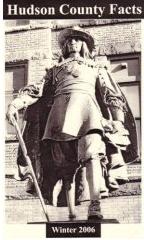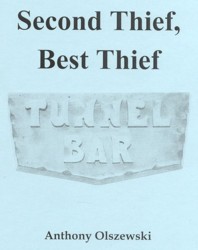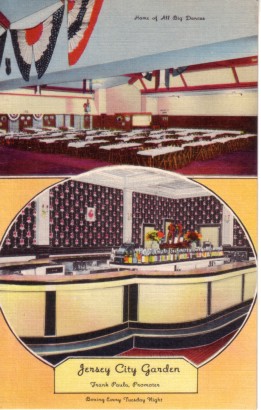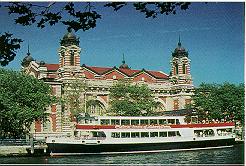
|
|

By: J. Owen Grundy, Historian and Louis P. Caroselli, Corporation Counsel The territory comprising what is now known as Jersey City was a wilderness,
occupied by the Lenni Lenape or Delawares, and governed by their tribal laws, until
Henry Hudson, an English navigator, in the employ of the Dutch East India Company,
seeking another route that would not require the passing of the Spanish coast to the
East Indies, and failing in his mission, found these shores. His little vessel about sixty
tons, with a crew of twenty men, anchored inside Sandy Hook on September 3, 1609.
He remained there nine days and made the acquaintance of the Indians, whom he
found "civil and kind", made a survey of the area, including Newark Bay. On September
12th he sailed up to Communipaw, where Robert Juet, his mate, wrote in the log that
was "...a very good land to fall in with, and a pleasant land to see."
After his return to Holland, the Dutch organized the United New Netherlands
Company to manage this territory and gave it the name New Netherlands. The
government of the company was vested in five chambers, nineteen delegates from
these chambers, with one delegate chosen by the States General, (the government of
Holland) formed an Executive Board, and this Board gave the Amsterdam Chamber the
management of affairs in New Netherlands. In June 1623, New Netherlands was
established as a province. One of the leading members of the Amsterdam Chamber
was Michael Pauw, a burgermeister of Amsterdam and Lord of Achtienhoven, near
Utrecht, who received a grant on the condition that he would plant a colony here of not
less than fifty persons, within four years. He chose the west bank of the Hudson River,
purchased the land from the Indians, and had the Indian chiefs join in the Deed with the
Company and the Governor of the Province. This grant bears the date November 22,
1630 and is the earliest known conveyance for what is now Jersey City.
The first settlement was at Communipaw, which stretched roughly from what is
now Johnston Avenue on the north to Caven Point on the south, where an indentation
of New York Bay called South Cove or Communipaw Bay (now filled in by the railroads)
reached up to what became Phillips Street, just east of Central Railroad of New Jersey
tracks, along the waterfront. A house was built here in 1633 for Jan Evertsen Bout,
superintendent of the colony, then called Pavonia. Shortly after, another house was
built at Harsimus (about present Fourth and Henderson Streets) where Harsimus Cove,
another indentation of New York Bay (also filled in) reached up to about the present line
of Henderson Street. This second house became the home of Cornelius Van Vorst,
who succeeded Bout as superintendent. These were the first two houses in Jersey
City.
In March 1638, William Kieft arrived here as Director General or governor of the
colony. He was a selfish and cruel administrator, whose bad treatment of the Indians
resulted in a number of massacres that destroyed the tiny settlements. In May 1647,
with the removal of Kieft, a new governor arrived. His name was Peter Stuyvesant.
Profiting from the sad experiences of his predecessor, he ordered that no new
settlement could be established unless it was enclosed and fortified. On March 1,
1660, Teilman Van Vleck and others petitioned "to settle on the maize land behind
Gemoenepaen," the Indian name from which Communipaw is derived.
This gave birth to the Village of Bergen, which reached from what is now Vroom
Street on the south to Newkirk Street on the north and from Tuers Avenue on the east
to Van Reypen Street on the west, with a tall log stockade built around it. What is now
Bergen Avenue was the road that ran through its center, with gates and block houses at
either end. A public square was laid out in its center, now Bergen Square. A well in the
middle was the city's first water works. A log structure, which served both church and
school, was the first church and school in New Jersey. On September 15, 1661, a
court was established here, consisting of "Schepens" or magistrates, who acted as both
Justices and Aldermen, or judicial and legislative officers. Tielman Van Vleck was the
first "Schout" and Herman Smeeman, Casper Stienmets and Michael Jansen, (ancestor
of the numerous and prominent Vreeland family) were the first "Schepens" - the
forerunners of all Hudson County's long roll of political leaders and public officials.
Soon afterward, another settlement sprang up again at Communipaw, but it
came under the government of Bergen. Its inhabitants reached Bergen by Jersey City's
first road, which followed the present line of Communipaw Avenue up to what is now
Summit Avenue, and up to Academy Street, which led to the school-house at Bergen
Square, giving Academy Street its name. From the Communipaw settlement grew
Lafayette, which was planned as a "suburban real estate development" by Keeney and
Halladay, building contractors in 1856. Lafayette was never a separate municipality,
however, but always a part of the Town of Bergen.
On May 25, 1664, an expedition sailed from England to seize New Netherlands,
which the English were to claim by virtue of the earlier exploration of the Cabots. They
secured the surrender of Stuyvesant and the Dutch on September 8, 1664. The
following February, Philip Carteret was named Governor of the colony, which the
English renamed New Jersey. He granted a new charter to the Town of Bergen, largely
confirming all the rights and privileges the inhabitants had enjoyed under the Dutch.
The boundaries in the new charter set forth an area that included all of present Jersey
City and Bayonne. In 1672, a war broke out between England and Holland and the
following year the Dutch recaptured their lost territory. Peace was established February
9, 1674, and under the terms of the Treaty of Westminister, New Jersey was restored to
England. Philip Carteret resumed the governorship and Dutch rules were passed from
these shores forever.
From that time to the American Revolution, the Town of Bergen was governed by
elected officials, subject first to the Lords Proprietors and subsequent to 1703 to Royal
Governors, named by the English sovereign and the Provincial Legislature, composed
of the Council, (now State Senate), and the Assembly. Disputes over rights to common
lands, (those lying outside the palisaded Village of Bergen) led to a new charter,
"Queen Anne's Charter" on January 14, 1714, granting Bergen even greater powers of
government. On December 7, 1763, the Legislature passed an Act providing for a
survey of the land held under Patents, and an allotment was made of the common
lands among the inhabitants. Commissioners were appointed to survey and allot the
lands and they prepared a Field Book giving the boundaries and title of tracts.
Completed in 1765, this was one of the most important events in the history of the
Township of Bergen, under English rule. It ended the land disputes.
In 1693, Bergen County was enlarged and divided into three townships, namely,
Township of Bergen, Township of New Barbados, and Township of Hackensack.
Bergen being one of the first four counties in the state, having come into existence by
an act of the General Assembly in 1682, which divided East Jersey into four original
counties: Bergen, Essex, Middlesex and Monmouth. The old Township of Bergen was
constituted in 1658, twenty-four years earlier, and ran from Bergen Point, Bayonne to
the northern boundary of present Hudson County. The area extending from the present
dividing line between the States of New York and New Jersey was the original
Township of Hackensack. The Township of New Barbados was roughly the area west
of the Hackensack River, comprising the West Hudson municipalities of today.
All of what is now Jersey City was carved out of what was originally the
Township of Bergen in the County of Bergen.
When the Township of Bergen was the only municipality between the Hudson
and Hackensack Rivers, its affairs were managed by trustees chosen for life. Later,
they were chosen annually by a plurality of voices. At this annual town meeting the
freeholders were accustomed to gather and decide questions of general interest which
were considered too weighty for the trustees. This meeting was presided over by a
moderator chosen for the purpose. The town clerk was clerk of this meeting. The
township was divided into road districts for better regulation of the highways and an
overseer appointed for each. They were known by the names of Bergen, Gemonepa,
Pemerahpogh, Sekakes, Wehauk, Maisland, (now New Durham), Bergen Woods, Bull's
Ferry and Bergen Point. The polling place, within the present confines of Jersey City
was at the Stuyvesant Tavern sometimes called Eagle Tavern, which was replaced by
Tise Tavern located at the southwest corner of Bergen and Glenwood Avenues. Until
1709, Bergen Village, (around Bergen Square, Jersey City) was the county seat and
the sessions of the court were held there, but after this date, the village of Hackensack
was designated as being more centrally located and more easily reached by the
majority of the inhabitants, and hence was chosen as the county seat of Bergen County
(which it remains) and the courts were moved there.
The first official division of a part of what is now Jersey City into a separate
municipality, with a government distinct and not beholden in any way to the Township of
Bergen occurred on February 22, 1838, when the State Legislature adopted an act
creating the "Mayor and Common Council of Jersey City," a new municipal corporation.
Up to this time, Jersey City had been part of the Township of Bergen. The referendum
of the inhabitants approved it. Dudley S. Gregory was elected the first mayor, and the
members of the first Common Council were Peter McMartin, James M. Hoyt, Williams
Glaze, Henry Southmayd, Isaac Edge, John Dows, John Griffith, Peter Bentley,
Jonathan Jenkins and Ebenezer Lewis. The temporary "City Hall" was Buck's Hotel, 68-70 York Street, a large frame building with a team entrance on the eastern end. The
Long Room was over the team entrance and here the Mayor and City Councilmen met.
Sometime later, the old school house on the north side of Sussex Street, just west of
Washington Street, was rebuilt and became a combination City Hall, municipal jail and
school house.
This "original" little municipality called Jersey City grew out of the area known as
Powles or Paulus Hook, a tract of solid land jutting out into the Hudson River, bounded
by Harsimus Cove on the north and south cove or Communipaw Bay on the south, and
separated from the marsh land on the west by a creek that had been enlarged about 20
feet in width, large enough for ordinary boats to pass. Warren Street was roughly its
western boundary. This area was purchased from the Dutch West India Company by
Abraham Planck. In 1698, it was purchased from Planck by Cornelius Van Vorst. In
1804 Anthony Dey, a prominent New York lawyer, acquired it and soon thereafter
passed title to Abraham Varick, also a prominent New Yorker, who the following day
conveyed the area to Col. Richard Varick (a former Mayor of New York who had been
General Washington's aide-de-camp in the American Revolution), Jacob Radcliff (a
former Mayor of New York) and Anthony Dey (a wealthy New York lawyer and cousin of
Col. Varick). These three were the leaders of The Associates of the Jersey Company,
whose charter was drafted by Alexander Hamilton. For fifteen years it possessed the
government and shaped the destiny of the infant community.
Feeling the need for a stronger municipal government, the Associates petitioned
the Legislature for a municipal charger and one was granted in 1820: "An Act to
Incorporate the City of Jersey, in the County of Bergen." In the body of the Act, the
name reads "Jersey City". Under this charter the inhabitants annually elected five
landowners to the Board of Selectmen. The Act named Dr. John Condit, Samuel
Cassedy, Joseph Lyon, John K. Goodman and John Seaman as the first board. On
January 23, 1829, the charter was amended and the corporate name changed to "The
Board of Selectmen and Inhabitants of Jersey City." However, the old name "City of
Jersey" was still retained in the title. On February 22, 1838, the name was changed to
the "Mayor and Common Council of Jersey City" and it was separated from the
Township of Bergen. On March 8, 1839, its boundaries were extended westerly along
the northerly side of First Street to the center of Grove Street, then southerly to South
Cove or Communipaw Bay, or the line of South Street extended. The city was enlarged
again on March 17, 1851, when a new charter was granted to include the Township of
Van Vorst after a majority of voters in both municipalities voted in favor of the merger.
Under this charter, the city was divided into four wards, each entitled to four aldermen.
On February 28, 1861, the fifth and sixth wards were created, on March 21, 1867, the
seventh ward, and on March 17, 1870, the eighth ward. Up to 1838, there was no
Mayor, the President of the Common Council being the head of the city.
The Township of Van Vorst which was consolidated with Jersey City in 1851
came into existence March 11, 1841, when it was separated from the Township of
Bergen. Its territory included the whole of what was once called Ahasimus or Harsimus.
It was bounded on the north by a creek separating it from Hoboken, on the south by Mill
Creek and Communipaw Cove, on the east by Grove Street and on the west it
extended up to the base of Bergen Hill. When the new township of Van Vorst was
separated from Bergen Township, it elected its own Township Committee, consisting of
Cornelius Van Vorst, Thomas Kingsford, Matthew Erwin, Jeremiah O'Meara and Elias
Whipple. It never had a Town Hall, The Township Committee met first in Bedford's Inn,
south side of Newark Avenue, between Grove and Barrow Streets and later in Weaver's
Arms, a tavern, on the south side of Newark Avenue near Jersey Street. At the time it
merged with Jersey City, Van Vorst had a population of 4,725 persons.
The Town of Hudson was taken from the Township of North Bergen (which
originally had been part of the Township of Bergen) and incorporated as a separate
municipality on March 4, 1852. Powers were vested in five supervisors. On April 11,
1855, it secured a new charter, incorporating "The City of Hudson." Governmental
powers were vested in a Mayor and Common Council.
Its Town Hall was on Oakland Avenue on the side of the old Third Precinct
Police Station, which still stands. Its first Mayor was General Edwin R.V. Wright, and its
first five Supervisors of Selectmen were Michael Fisher, William H. Danielson, Stephen
Terhune, John Tise and Theodore McCabe. The City of Hudson extended from the
Pennsylvania Railroad cut (at present Journal Square) to Paterson Plank Road, west of
Mill Creek and Hoboken, and eastward to Penhorne Creek and Hackensack River. In
1854, it had a population of 2,633 persons. Its last Township Committee meeting was
held April 30, 1870.
The Township of Greenville was created March 18, 1863. In its charter it was
described as: "That part of the Township of Bergen, formerly known as Washington
School District No. Three, bounded on the east by the New York Harbor, on the south
by the Morris Canal, (which separated it from Bayonne) on the west by Newark Bay and
on the north by a lane or road known as Myrtle Avenue." The first Township Committee
of Greenville was composed of five members, John Wauters, Henry Van Nostrand,
Peter Rowe, James Currie and George Vreeland, Sr. It never had a Town Hall. The
Township Committee meetings were in various hired halls. The Township of Greenville
went out of existence in 1873, when its voters by 261 in favor and 45 against voted to
merge with Jersey City.
In the meantime, the old Township of Bergen, much reduced in size, remained.
It extended from the Pennsylvania Railroad cut (at present Journal Square) on the
north, to Myrtle Avenue on the south, on the east by Mill Creek and New York Bay and
on the west by Hackensack River. What is now the Lafayette section, which included
the old Dutch village of Communipaw, was included in the Town of Bergen. On March
24, 1855, Bergen obtained a new charter, becoming the Town of Bergen, with a Town
Council of five members, with Garret Sip as its first president. Its population at this date
was 4,972 persons. In 1866, the Town of Bergen was granted a new charter, providing
for a Mayor and Council. Henry Fitch was elected the first Mayor of the Town of
Bergen. The Town Hall occupied the upper floor of Smith's of Prospect Hall, which
faced the public square, where Jewett, Storms and Fairmount Avenues converge. It
burned down June 12, 1867, and the town government moved to the upper floor of
Monticello Hall, corner of Monticello and Belmont Avenues, where it remained until
Library Hall, which still stands at 704-708 Grand Street, was built on November 15,
1866.
In 1868, a new charter put an end to the old Town of Bergen and created the
City of Bergen in its stead. John Hilton was elected first Mayor. Library Hall continued
as the seat of the city government until the City of Bergen, through its last Mayor,
Stephen D. Harrison, issued a call for a convention to consider consolidation. This was
in 1869. Its last Board of Aldermen consisted of William H. Bumsted, David L. Holden,
Henry H. Brinkerhoff, Issac Romaine, H. Sigler, J. Soper, James Stevens, M.D.
Vreeland, William Van Keuren, Edgar D.B. Wakeman, Marcius H. Washburn and Issac
Freese, Jr.
The Legislature passed a bill providing for a referendum on consolidation
to be held on October 5, 1869 and on that date Jersey City, Hudson City, Bergen, Town
of Union (sometimes called Union Hill which later joined with West Hoboken to form
present Union City) and Union Township voted in favor of consolidation. Hoboken,
Bayonne, Greenville, Weehawken, West Hoboken and North Bergen voted against it.
Although the residents of the Town of Union and Union Township wanted to join the
consolidated city, the Act provided that only contiguous municipalities could consolidate
and therefore they were excluded. On March 17, 1870, the Legislature granted a new
charter for the consolidated City of Jersey City consisting of former Jersey City, Hudson
County and the Town of Bergen.
Greenville struggled on for a time, as an independent township, but it was having
financial difficulties, mainly over the street improvements, and in 1873, as the result of a
referendum (262 for, and 45 against consolidation) merged with the new City of Jersey
City and Greenville ceased to exist as a separate identity.
Charles H. O'Neill, who was mayor of Jersey City, at the time of the
consolidation, was now mayor of the greater Jersey City. The City government, in
addition to the Mayor, consisted of a Board of Aldermen of twelve members, and
Boards of Public Works, Police Commissioners, Fire Commissioners, Finance and
Taxation, and Board of Education. The Mayor, Aldermen and Board of Education were
elected. Members of Boards of Police, Public Works and Finance and Taxation were
appointed by joint session of the state Legislature. Three police justices (now
magistrates) were also appointed by the joint session. This method of selecting city
officials was changed by another charter in 1887, providing for election of members of
various municipal boards by the people of Jersey City, rather than the legislature, and
thus home rule was restored. In 1894, changes were made in the city government by
an act of the Legislature, with the result that many improvements were instituted such
as new schools and improved streets. The last mayor under this form of government
was H. Otto Wittpenn.
In the early days, the municipal government of Jersey City met in the old Lyceum
at 109 Grand Street and, afterward, for a time on the northside of Sussex Street, just
west of Washington Street. On April 1, 1961, the new City Hall was opened; it was at
the southwest corner of Newark Avenue and Cooper Place. Behind it on Gregory
Street, the police headquarters and city jail were located. The present City Hall,
occupying the square block bounded by Grove, Montgomery, Henderson and Mercer
Streets, was opened January 1, 1896, and continues as the seat of municipal
government.
In 1913, the form of government was changed to the Commission form under the
"Walsh Act." The commission consisted of five members elected by the people. Each
headed a department as director and all executive and legislative powers were vested
in them. They chose one among themselves as mayor who merely presided as a
Chairman of the Board. The first commissioners elected were Mark M. Fagan, George
F. Brensinger, A. Harry Moore, James J. Ferris and Frank Hague and Mr. Fagan, who
had been a mayor under the old Aldermanic form, was chosen by his colleagues as the
first mayor under this commission form of government. He headed the Department of
Public Affairs, Bresinger was assigned to Revenue and Finance, Moore to Parks and
Public Property, Ferris to Streets and Public Improvements and Hague to Public Safety,
(which consisted of Police and Fire Departments).
In 1961, Jersey City abandoned the Commission form of government and
adopted Plan C under the Optional Municipal Charter Law (Chapter 210 of New Jersey
Laws 1950). The number of wards were reduced from twelve to six. The Mayor and
three Council members are elected by the voters of the entire city and the voters of
each ward elect one councilman, making a total of nine councilmen. The nine council
members choose one of its members to be Council President. The Mayor is the chief
executive of the city and appoints the heads of the various departments in the city and
members of the Board of Education, as well as other municipal boards and
commissions. This is the form of municipal government which is in existence in Jersey
City today.
1970


GRAVE ROBBER Jersey City Computer Repair
297 Griffith Street, Jersey City, NJ - In the Heights just off of Kennedy Blvd. - Very close to Journal Square and Union City, just five minutes away from Hoboken, Downtown Jersey City, Newport, and the Waterfront - Tech support for The Jersey City Mayor's Office
suring the administration of Bret Schundler - PC repair - upgrade, hardware install, software install, data recovery, spyware removal, virus removal, replace hard drive


|
|
|
|